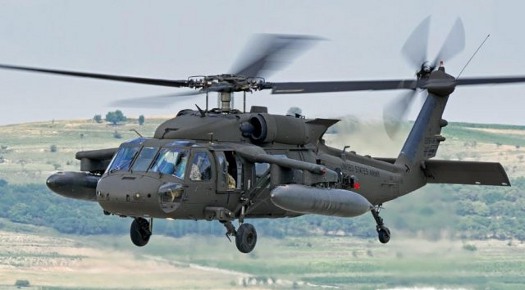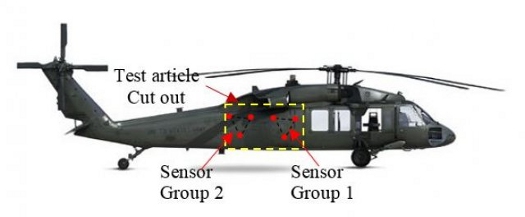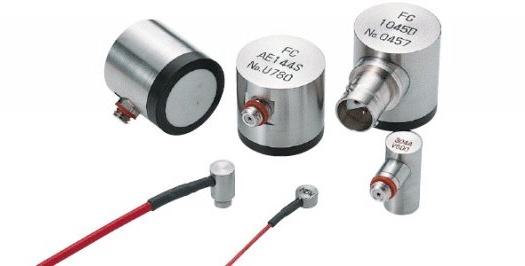 |
| November 21, 2017 | Volume 13 Issue 43 |
Designfax weekly eMagazine
Archives
Partners
Manufacturing Center
Product Spotlight
Modern Applications News
Metalworking Ideas For
Today's Job Shops
Tooling and Production
Strategies for large
metalworking plants
Wings:
In a first for U.S. Army, sensors detect aircraft damage as it occurs

A new damage-sensing network is integrated into a conceptual composite UH-60M Black Hawk rotorcraft. [Photo Credit: U.S. Army photo]
By T'Jae Ellis, Army Research Laboratory
For the first time ever, a team of researchers successfully developed and tested networked acoustic emission sensors that can detect airframe damage on conceptual composite UH-60 Black Hawk rotorcraft.
Researchers with the U.S. Army Research Laboratory and the U.S Army Aviation and Missile Research, Development and Engineering Center said their discovery opens up possibilities for new onboard features that could immediately alert the flight crew to the state of structural damage like matrix cracking and delamination as they occur, giving the crew greater opportunity to take corrective actions before catastrophic failure.
ARL has been studying several possible alternatives to rotorcraft airframe health monitoring. This effort, which began almost two years ago, makes a strong case for integrated real-time damage-sensing methodologies on future airframe structures. The sensing method can be used to reliably detect and locate the initiation and growth of damage that may occur during service.
"Future Army airframe structures are required to be lighter, safer, and ultra reliable," said Dr. Mulugeta Haile, research aerospace engineer. "To achieve these, the Army must adopt a combined strategy of implementing advanced structural design methods, improved structural materials, and integrated damage-sensing and risk-prediction capabilities."
He said the team turned to acoustic emission tests because other methods such as ultrasonic and radiography require an external energy source in the form of a directed wave.
"The external energy has the undesirable effect of interfering with other systems of the aircraft. In addition, other methods are not as good as AE in detecting early damage," he said.
Acoustic emission sensing is a passive, non-destructive technique for detection of damage in the very early stage, and long before the structure experiences catastrophic failure. Unlike other methods, Acoustic emission detects damage in real time (or at the instant the damage is happening). The fact that AE is passive means that it does not require an external energy to detect damage. It relies on the energy that is initiated within the structure, Haile explained.

The approximate cut-out location of the test article and location of group sensors. Sensor groups 1 and 2 are shown. Groups 3 and 4 are on the opposite side. [Photo Credit: U.S. Army illustration]
"The novelty of the current work is that we introduced several new concepts on wave acquisition control and signal processing to recover damage-related information in networked acoustic emission sensors," Haile said. "The Eureka moment was when the sensing network consistently identified and located the initiation and progression of damage during a prolonged fatigue test that lasted over 200,000 cycles -- a feat that has never been achieved before."
The ARL sensing network is composed of several lightweight transducers encapsulated in 3D-printed non-intrusive sensor mounts. Sensors of the network are optimally distributed in multiple zones to maximize coverage as well as probability of damage detection. The data acquisition process is embedded with a software-controllable timing parameter to reject reflections of a direct wave, as well as waves coming from non-damage-related events. Meanwhile, the signal-processing algorithm is augmented with a layer of adaptive digital filters to minimize effects of signal distortion during location analysis.
Dr. Jaret Riddick, director of the Vehicle Technology Directorate, along with Haile, Nathaniel Bordick, and other ARL partners, collaborated to elucidate detailed mechanisms for full-scale damage detection in complex rotorcraft structures using the distributed sensor architecture. Key to the technique is the development of signal distortion control parameters, acquisition timing control, and 3D-printed sensor capsules.
"The downtime due to routine inspection and maintenance represents the major fraction of the life cycle cost of Army platforms, because we are not using the platform and we have to pay for inspection, which in most cases reveals no damage. So the idea is to integrate a reliable damage-sensing network and perform maintenance only when necessary," Riddick said.

Acoustic emission sensors used in the distributed network are lightweight broadband piezoelectric crystals. [Photo Credit: U.S. Army photo]
Currently, the Army sustains its fleet using a phase maintenance paradigm, which is a periodic calendar-based practice that requires inspection and maintenance at fixed time intervals. The process is highly inefficient, costly, and entails extended downtime. The newly developed sensing network will enable condition-based maintenance or maintenance on demand. It has the potential to drastically cut the life cycle cost of Army vehicles. The work also supports the Army's long-term vision of maintenance-free aircraft.
"Large-scale AE monitoring is a data-intensive process with several million hits being received by each transducer per flight," Halle said. "This puts a higher load on the internal bus and circuitry of any data acquisition hardware. In general, most hits are not related to damage. Rather, they are noises from moving parts such as the clicking or rubbing noises of fasteners, panel connections, and vibrations from other non-damage-related sources. Unwanted AE hits also arise due to reflections of an already received and processed AE wave. The challenge is to develop a system that is sensitive only to damage-related hits and insensitive to all other hits."
"Most of the available AE-based structural health monitoring is for simple plate-like structures, despite most airframe structures not being simple plates," Bordick said. "Not much has been done on integrated full-scale airframe health monitoring using AE. The problem is quite complex. I'm glad that we were able to successfully develop and demonstrate the sensing network."
Published November 2017
Rate this article
View our terms of use and privacy policy
